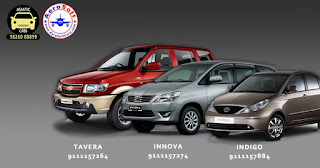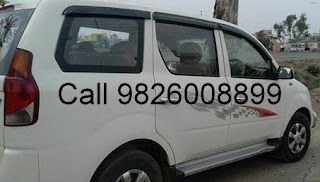Ford Fiesta Best Car Taxi in Indore, Call 098 26 00 88 99
The Fiesta was originally developed under the project name "Bobcat" (later to be used on a badge engineered version of the Ford Pinto called the Mercury Bobcat) and approved for development by Henry Ford II in September 1972. Development targets indicated a production cost US$100 less than the current Ford Escort.The car was to have a wheelbase longer than that of the Fiat 127, but with overall length shorter than that of Ford's Escort. The final proposal was developed by Tom Tjaarda at Ghia. The project was approved for production in autumn 1973, with Ford's engineering centres in Cologne and Dunton (Essex) collaborating.
Name Fiesta belonged to General Motors at the time; however, it was freely given for Ford to use on their new B-class car. After years of speculation by the motoring press about Ford's new car, it was subject to a succession of carefully crafted press leaks from the end of 1975. A Fiesta was on display at the Le Mans 24 Hour Race in June 1976, and the car was launched and on sale in France and Germany in September 1976: to the frustration of UK dealerships righthand drive versions only began to appear in the UK in January 1977.
Generation of Ford Fiesta
First generation (1976–1983)
Mechanically, the Ford Fiesta followed tradition, with an end-on four-speed Manual transmission of the Ford BC-Series mounted to a new version of the Ford Kent OHv Mechanically, the Ford Fiesta followed tradition, with an end-on four-speed Manual transmission of the Ford BC-Series mounted to a new version of the Ford Kent OHV engine, dubbed "Valencia" after the brand new Spanish factory in Almussafes, Valencia, developed especially to produce the new car. Ford's plants in Dagenham, England, and Saarlouis and Cologne (from 1979) in Germany, also manufactured Fiestas. To cut costs and speed up the research and development, many modified Kent engines destined for the Fiesta were tested in Fiat 127s – at the time considered the benchmark car in the class, with which the Fiesta shares styling similarities. This also allowed covert road testing across Europe.
Although not the first Ford vehicle to feature front-wheel drive (the 1960s Taunus produced by Ford of Germany laid claim to that title), the Fiesta is widely credited as being Ford's first globally successful front-wheel-drive model. UK sales began in January 1977, where it was available from £1,856 for the basic 950 cc-engined modeengine, dubbed "Valencia" after the brand new Spanish factory in Almussafes, Valencia, developed especially to produce the new car. Ford's plants in Dagenham, England, and Saarlouis and Cologne (from 1979) in Germany, also manufactured Fiestas. To cut costs and speed up the research and development, many modified Kent engines destined for the Fiesta were tested in Fiat 127s – at the time considered the benchmark car in the class, with which the Fiesta shares styling similarities. This also allowed covert road testing across Europe.
Second generation (1983–1989)
The Fiesta Mark II appeared towards the end of summer 1983 with a revised front end and interior, and a bootlid mirroring the swage lines from the sides of the car. The 1.3 L OHV engine was dropped, being replaced in 1984 by a CVH powerplant of similar capacity, itself superseded by the lean burn 1.4 L two years later. 957 and 1,117 cc engines continued with only slight alterations and for the first time a Fiesta diesel was produced with a 1600 cc engine adapted from the Escort.
The new CTX continuously variable transmission, also fitted in the Fiat Uno eventually appeared early in 1987 on 1.1 L models only. This gearbox provided a quick and economic driving experience, despite the resemblance of the sensation of the continuously variable transmission to that of a slipping clutch.
The second generation Fiesta featured a different dashboard on the lower-series trim levels compared to the more expensive variants. The XR2 model was thoroughly updated with a larger bodykit. It also featured a 96 bhp (72 kW) 1.6 L CVH engine as previously seen in the Ford Escort XR3, and five-speed gearbox (also standard on the 1.3 L CVH models). The engine was replaced by a lean-burn variant in 1986 which featured a revised cylinder head and carburettor; it was significantly cleaner from an environmental viewpoint but was slightly less powerful as a result (95 bhp/71 kW).
THIRD GENERATION (1989–1997)
The third generation Fiesta Mark III, codenamed BE-13 was unveiled at the end of 1988 and officially went on sale in the February of the following year. Although it was essentially a reskin of the second generation Fiesta (which in turn was a facelift of the 1976 original), it looked radically different, and did address the principal weakness of the previous generation – the lack of a 5-door derivative, something that was by then available in its major rivals such as the Fiat Uno, Peugeot 205 and Opel Corsa The other main change was to the running gear – the improved HCS (High Compression Swirl) version of the Kent/Valencia powerplant. The CVH units from the second generation were carried over largely unmodified. The diesel engine was enlarged to a 1.8L capacity.
This model had the longest production life of any Fiesta to date, achieved the highest yearly sales of any Fiesta in the early 1990s – achieving a sales volume of 1 million units inside the first two years of production, and underwent numerous changes in its life. For example, the car had four different versions of standard steering wheels during its lifetime (the launch wheel, then updated in 1992, 1994 and 1995) and the most changes to standard UK trim levels of any Fiesta (examples across the years show the large line-up: Popular, Popular Plus, L, LX, Ghia, 1.6S, XR2i, RS Turbo, RS1800, Fiesta, Louisiana, DL, SX, Azura, Si, Classic, Classic Quartz, Classic Cabaret, Saphire). A Fiesta-derived van, the Ford Courier, was launched in 1991.
FOURTH GENERATION (1995–2002)
he all new Fiesta Mark IV (internal code name was BE91) was launched in 1995 and became Britain's best-selling car from 1996 to 1998.
The model used the chassis of the Mark III car but most components were heavily revised, including a new suspension system, which gave the Fiesta one of the best handling abilities in its class.
The model featured a range of new Zetec-SE engines, available in 1.25 L and 1.4 L forms, the 1.8 diesel engine was slightly modified for the Mark IV, now marketed as the "Endura DE". Lower specification models remained available with what would be the final edition of the Kent 1.3 L OHV engine, now known as Endura-E. As well as the major changes to the chassis, the Mark IV also benefited from a new interior and exterior styling, including a soft painted instrument panel for the first year of production, albeit maintaining a similar dimensions to the Mark III. The RS1800 and RS Turbo models were not carried over to the updated Fiesta range.
FIFTH GENERATION (2002–2008)
On 1 April 2002, the all new fifth-generation car was unveiled. Of this Fiesta Mark V, most engines were carried over from the previous Fiesta, but renamed "Duratec", as the "Zetec" name was now solely used for sportier models. The previous push-rod 1.3 L engine was initially available in the UK, but this was quickly replaced with a Rocam 1.3 L, both under the name Duratec 8v.[Trim levels available initially were Finesse, LX, Zetec and Ghia, with limited edition variants soon following. The fifth generation was also the first Fiesta to feature the Anti-lock Braking System and passenger airbags as standard. The fifth generation was known as Mark VI in United Kingdom and elsewhere due to the fourth generation facelift being commonly referred to as the Mark V. This generation became the best-selling Ford Fiesta generation to date.
Engines available include 1.25 L, 1.3 L, 1.4 L, 1.6 L, 2.0 L petrol, plus 1.4 L 8v and 1.6 L 16v Duratorq TDCi common-rail diesels built in a joint venture with PSA.
This was also the first Fiesta to be sold in Asia and Australasia (all 1.6 L LX 3dr/5dr, Zetec 3dr, Ghia 5dr), replacing the Kia-based Festiva. This Fiesta generation was ergonomically and mechanically more advanced than any previous generation. The 2005 facelift came with an even improved exterior.
SIXTH GENERATION (2008–PRESENT)
The sixth generation, or Ford Fiesta Mark VI,was shown in concept form as the Ford Verve at the Frankfurt Motor Show in September 2007 and marketed in principal European markets,Australia and the United States. This model is based on Ford's new global B-car platform. The sixth generation is known as Mark VII in the United Kingdom. Production started at Ford's Cologne plant in Germany in August 2008. A second plant in Valencia, Spain started production in early 2009. Productions in China, Thailand and Mexico started from late 2008 to 2010.
Fiesta sales for Canada began in June 2010 for model year 2011. The 5-door hatchback will also be sold in Mexico starting 2011.The sixth generation saloon was launched in India in July 2011 with both petrol and diesel variants.The Fiesta received a September 2012 face lift with changes to the front, back and the interior.
Er. Bhawna Sharma [ MCA ]
Software Engineer / Webmaster
www.AeroSoftCorp.com
www.AeroSoft.in
www.AeroSoft.co.in
www.AeroSoftseo.com
On Line Assistence :
Gtalk : Bhawna.AeroSoft@gmail.com
Y! Messenger : Bhawna.AeroSoft@yahoo.com
Rediff Bol : Bhawna.AeroSoft@rediffmail.com
MSN : Bhawna.AeroSoft@hotmail.com
| www.a1-cabs.co.in/ |












Thanks for this posting!
ReplyDeleteNice & very informative blog.
Internet Marketing Training Delhi
This comment has been removed by the author.
ReplyDeleteThis comment has been removed by the author.
ReplyDeleteThis comment has been removed by the author.
ReplyDeleteThis comment has been removed by the author.
ReplyDeleteHi,I gone through your blog.Having good information.Thanks for sharing useful information about Car rentals .
ReplyDeleteBook Mumbai to Mahabaleshwar Cabs Online at cabs2go Car Rentals. Trust cabs2go for the Best
ReplyDeletemumbai to Mahabaleshwar taxi Services.